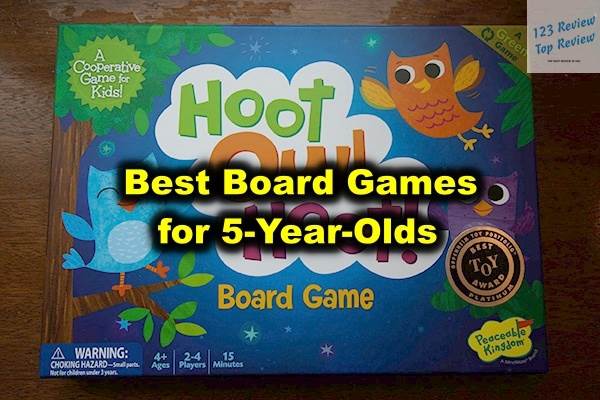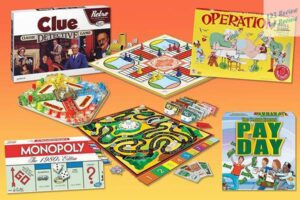Board games offer an exceptional way to combine fun with learning, making them an ideal activity for young children. For 5-year-olds, the right board game can ignite their imagination, foster important social skills, and promote cognitive development. Whether you’re looking for a way to keep your child entertained, or seeking an activity that brings the whole family together, selecting the perfect board game is key.
 In this article, 123 Review’ll delve into the best board games for 5-year-olds, highlighting different types of games, what features to look for, and how to choose the best one for your child.
In this article, 123 Review’ll delve into the best board games for 5-year-olds, highlighting different types of games, what features to look for, and how to choose the best one for your child.
Top Recommended Board Games for 5-Year-Olds
When choosing a board game for a 5-year-old, it’s essential to consider the child’s developmental stage, interests, and the skills you’d like to help them develop. From cooperative games that teach teamwork to classic games that have stood the test of time, here are some top recommendations:
Cooperative Games for 5-Year-Olds
Cooperative games are particularly beneficial for young children as they emphasize teamwork, communication, and collective problem-solving. Instead of competing against one another, players work together to achieve a shared goal, fostering a sense of camaraderie and reducing the pressure of winning and losing. This type of gameplay can help children learn to cooperate with others, share ideas, and make group decisions.
- “Hoot Owl Hoot!” – In this charming game, players collaborate to help a group of owls return to their nest before the sun rises. The game is simple enough for 5-year-olds to grasp quickly, yet it requires players to think strategically about how to get all the owls home in time. The cooperative nature of the game helps children develop teamwork skills, and the colorful board and owl tokens keep them engaged throughout.
- “Outfoxed!” – This delightful detective game involves players working as a team to solve the mystery of who stole Mrs. Plumpert’s prized pot pie. Players gather clues and eliminate suspects as they move around the board. The game encourages logical thinking, deduction, and cooperation, making it an excellent choice for young children who enjoy a bit of mystery and adventure.
Classic Games Suitable for 5-Year-Olds
Classic board games often have timeless appeal due to their simplicity, engaging gameplay, and the nostalgia they evoke for parents. These games typically have straightforward rules that are easy for young children to understand and enjoy, making them a staple in many households.
- “Candy Land“ – A sweet, colorful journey through the magical Candy Land, this game is perfect for introducing young children to board games. Players move their pieces along the path by drawing cards that tell them which color square to move to next. The game is easy to play, doesn’t require reading skills, and offers a delightful visual experience. It’s a great way to introduce concepts like taking turns and following rules.
- “Chutes and Ladders“ – This classic game, known as “Snakes and Ladders” in some parts of the world, is a favorite among young children. The game teaches basic counting and number recognition as players move their pieces up ladders and down chutes based on the roll of a dice. The element of surprise keeps children engaged, and the simple rules make it an ideal choice for 5-year-olds.
Educational Board Games for 5-Year-Olds
Educational board games are designed to be both entertaining and instructive, making them an excellent choice for parents who want to incorporate learning into playtime. These games often focus on skills such as counting, reading, matching, and critical thinking, providing valuable educational benefits in a fun and relaxed setting.
- “Zingo!” – A fast-paced, bingo-like game that helps children develop their vocabulary and word recognition skills. Players race to match words and pictures on their cards with tiles dispensed from the Zingo! machine. The game is engaging and competitive, yet simple enough for young learners to understand. It’s also a great way to build language skills and encourage quick thinking.
- “The Sneaky, Snacky Squirrel Game“ – In this fun and educational game, players help their squirrel collect acorns by spinning a spinner and using a squirrel-shaped grabber to pick up acorns of different colors. The game helps develop fine motor skills, hand-eye coordination, and color recognition. It also encourages strategic thinking as players decide which acorns to collect and how to best use their turns.
Interactive and Engaging Games for Young Players
Interactive games keep young children engaged by requiring active participation and often include elements of building, acting, or storytelling. These games can captivate a child’s attention, making them ideal for longer play sessions and group activities.
- “Mouse Trap” – A game that combines building with gameplay, “Mouse Trap” requires players to construct a complex mousetrap contraption as they move their pieces around the board. The game is exciting and unpredictable, as players never know when the trap will be sprung. It’s great for developing fine motor skills, understanding cause and effect, and encouraging patience.
- “Don’t Break the Ice” – In this suspenseful game, players take turns tapping out blocks of ice from a tray while trying not to let the figure sitting on top fall through. The game is simple, but it keeps children on the edge of their seats as the tension builds. It’s perfect for developing hand-eye coordination and fine motor skills, and the quick pace makes it a hit with young players.
Characteristics of Great Board Games for Kids
When choosing a board game for a 5-year-old, certain characteristics can make the difference between a game that’s played once and a game that becomes a beloved favorite. Here are some key features to look for:
Simple Rules and Instructions
Young children benefit most from games that have clear, simple rules. Games that are too complex can lead to frustration, so it’s important to choose games where the instructions are easy to follow and the gameplay is straightforward. Ideally, the game should be easy enough for the child to play with minimal assistance after an initial explanation.
Engaging Themes and Visuals
For a board game to capture and hold the attention of a 5-year-old, it should feature bright colors, fun themes, and engaging visuals. Themes that resonate with their interests—such as animals, fairy tales, or adventure—can make the game more appealing. Visuals that are attractive and vibrant can also help maintain their interest and make the game more enjoyable to play.
Short Playtime for Attention Span
Given that 5-year-olds typically have shorter attention spans, it’s important to choose games that have a quick setup and relatively short playtime. Look for games that can be completed in 15 to 30 minutes. This duration is long enough to engage your child but short enough to keep them from losing interest.
Popular Game Types for 5-Year-Olds
Different types of games offer various benefits, from improving fine motor skills to enhancing memory and strategic thinking. Here are some popular types of board games that are well-suited for 5-year-olds:
Dexterity Games for Fine Motor Skills
Dexterity games are excellent for helping young children develop hand-eye coordination and fine motor skills. These games often involve physical activities like stacking, balancing, or carefully placing pieces, which require precision and control.
- “Jenga” – A game of physical skill and precision, “Jenga” involves players taking turns removing blocks from a tower and placing them on top without causing the tower to collapse. The game is simple yet challenging, and it helps improve fine motor skills, hand-eye coordination, and patience.
- “Animal Upon Animal” – In this balancing game, players take turns stacking wooden animals on top of each other without letting the pile fall. The game is both fun and challenging, and it encourages the development of fine motor skills, hand-eye coordination, and strategic thinking.
Strategy Games Appropriate for Young Minds
Strategy games introduce young children to the basics of planning, decision-making, and critical thinking. These games often involve choosing actions that affect the outcome of the game, helping children learn to think ahead and make informed decisions.
- “Connect 4” – A simple yet strategic game where players take turns dropping colored discs into a vertical grid, aiming to get four of their pieces in a row. The game encourages strategic thinking, as players must plan their moves while anticipating their opponent’s next move. It’s a great way to introduce the concept of strategy in a fun and accessible way.
- “Guess Who?” – A two-player game that involves asking yes or no questions to eliminate characters and guess the opponent’s mystery character. The game is easy to learn and play, and it encourages logical thinking, deduction, and strategic questioning.
Memory Games for Cognitive Development
Memory games are perfect for developing a child’s cognitive abilities, including memory, concentration, and pattern recognition. These games often involve matching pairs or recalling items, which can help improve a child’s focus and attention to detail.
- “Memory” – A classic card game where players take turns flipping over cards to find matching pairs. The game is simple but challenging, and it helps improve memory, concentration, and visual recognition skills. The game can also be adapted to different themes, such as animals or numbers, to align with your child’s interests.
- “Go Fish” – A simple card game that involves players asking each other for specific cards to form pairs. The game is easy to learn and play, and it helps develop memory, concentration, and social interaction skills. It’s a great way to introduce young children to the concept of card games and turn-taking.
How to Choose the Right Board Game
Selecting the perfect board game for a 5-year-old involves considering several factors to ensure it matches their developmental stage and interests. Here are some key points to keep in mind when choosing a game:
Consideration of Child’s Interests
One of the most important factors to consider when choosing a board game is your child’s interests. If your child loves animals, for example, they’re more likely to enjoy a game that features wildlife. Similarly, if they’re interested in adventure or fantasy, a game with a corresponding theme will likely capture their attention. Choosing a game that aligns with their interests can make the experience more enjoyable and engaging for them.
Age Appropriateness and Complexity Levels
It’s crucial to ensure that the game is age-appropriate in terms of difficulty. Games designed for 5-year-olds will typically have simpler rules and concepts that align with their cognitive and motor skill levels. Avoid games that are too complex or that require advanced reading skills, as these can lead to frustration and disengagement. Many board games are labeled with an age range, which can be a helpful guide when selecting a game.
Player Count and Social Interaction
Consider how many players the game requires. Games that can be played with the whole family or with friends are great for encouraging social interaction and developing social skills. Multiplayer games also provide opportunities for children to learn about taking turns, cooperating with others, and managing the social dynamics of play.
Tips for Playing Board Games with Children
Playing board games with children can be a highly rewarding experience, both for the child and the adult. Here are some tips to ensure that the experience is positive and enjoyable:
Encouraging Turn-Taking and Sportsmanship
Teaching children the importance of taking turns and being a good sport is essential when playing board games. Emphasize the idea that playing games is about having fun, not just about winning. Encourage your child to congratulate others when they win and to handle losing gracefully. This helps them develop social skills, emotional resilience, and a positive attitude toward competition.
Setting Up a Positive Game Environment
Creating a comfortable and positive environment for playing games is crucial to ensuring that everyone has a good time. Make sure the play area is free of distractions, and that everyone is in a good mood before starting the game. You can also set the tone by being enthusiastic and patient, and by helping your child understand the rules before starting the game.
Managing Expectations for Winning and Losing
Help your child understand that the goal of playing games is to have fun and learn, not just to win. Encourage them to try their best, but remind them that losing is also part of the game and an opportunity to learn. If your child is particularly sensitive to losing, you can start with cooperative games where everyone wins or loses together, which can help ease the pressure.
In conclusion, choosing the right board game for a 5-year-old involves careful consideration of their interests, developmental stage, and the type of experience you want to create. By selecting games that are engaging, age-appropriate, and fun, you can provide your child with a rich and enjoyable experience that promotes their growth and development. Whether you’re introducing them to the world of board games for the first time or adding to their existing collection, these games offer a wonderful opportunity for learning, bonding, and, most importantly, having fun. Happy gaming!





